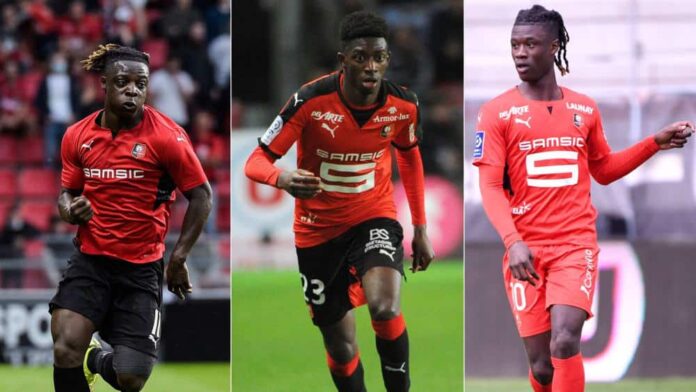Stade Rennes regularly produces talent for Europe’s top clubs. It has to do with a radical paradigm shift – and Salma Hayek’s husband.
Stade Rennes owe their identity to the “new Ronaldo”. The “new Ronaldo” was the biggest transfer flop in the club’s history.
In 2000, the Brazilian centre-forward Lucas Severino, whom Inter Milan’s president Massimo Moratti had chosen as the successor to his former striker, was worth 150 million francs (a good 21 million euros) to the then middle-class club. 72 league games and six goals later, Severino was transferred to Japan – and the club’s philosophy along with him.
Dembelé, Camavinga, Rutter: Talented players on the run
Somewhere it is an expression of success that Severino remained the most expensive purchase in the club’s history until 2020. Even more so, it’s probably the strong season the current fourth-placed team is currently having in Ligue 1 and the Europa Conference League. And most of all, it is the look at the departures of the past few years.
Ousmane Dembelé became one of the most expensive players in the world, Eduardo Camavinga the heir apparent at Real Madrid, Tiemoué Bakayoko a million-dollar deal for AS Monaco when he was sold on to Chelsea FC, Edouard Mendy the guarantor of Chelsea’s Champions League victory. Sofiane Diop, who was also sold to Monaco, is currently regarded as France’s great new playmaking talent, Georginio Rutter is emerging as one of the Bundesliga’s shooting stars at Hoffenheim – and in England, Ismaila Sarr has reportedly played his way into the focus of Liverpool FC at Watford FC. All but Mendy hail from Rennes’ youth academy.
More than five first-team players per junior year
In total, L’Equipe calculated, a whopping 34 players from Rennes’ youth academy have made it into the squad of a Ligue 1 club between 2014 and 2020 alone. That makes for an almost uncanny quota of more than five future first division players per year.
In the self-proclaimed “League of talents”, in which clubs rely on their youth work, Rennes is the role model that many other French clubs emulate. Even without a big city like Paris, Lyon or Marseille as a demographic driving force, the club from the small university town has become – measured by the size of the club – probably the most successful talent factory in all of Europe in recent years. And that has a lot to do with Lucas Severino.
In 1998, the Breton multi-billionaire Francois Pinault bought the club through his financial holding company Artemis and initially did exactly what rich owners did with football clubs around the turn of the millennium: He pumped money into the club, wanted to improve the image of the grey mouse with luxury transfers and bought rows and rows of South Americans. The success of this approach: on a scale of 1 (Lucas Severino) to 10 (Ronaldo) rather not in double figures.
Now Pinault probably wouldn’t have become the third richest man in France if he didn’t know how to absorb losing trades. And so in 2002 he decided on a radical paradigm shift: less South America, more Brittany. He quadrupled the budget for youth work, which has since remained constant at between seven and ten per cent of the total budget. For comparison: according to the DFL report, the average expenditure of Bundesliga clubs in 2020 was less than four per cent.
Gucci, Balenciaga, Puma – and Stade Rennes
“The youth development centre is at the heart of our strategy,” club president Nicolas Holveck told L’Equipe in 2020. “We rely on our young players to progress.” In France, only Paris St Germain currently spends more money on its youth development centre – for well-known reasons.
Pinault’s ambitious goal almost 20 years ago: Half of the professional squad should come from his own academy, if possible even from Brittany. He handed over the business to his son Francois-Henri a short time later. As owner and CEO of the Kering empire, he owns the brands Gucci, Balenciaga, Puma – and Stade Rennes. He is married to actress Salma Hayek and has a child with model Linda Evangelista.
A man with a penchant for extravagance, you might think. But “FHP”, as he is called in France, is not a man of the flash. He rarely gives interviews, preferring the stands of the rather austere Roazhon Park in Rennes to the red carpet, they say.
So the adherence to his father’s philosophy is only surprising at first glance. Producing starlets before they achieve great fame elsewhere: Pinault, of all people, the luxury boss and glamour husband, has turned his home club into the anti-Hollywood.
When Rennes beat the favoured PSG in the 2019 Coupe de France final to win a title again after a 48-year wait, “FHP”, who mostly stays in the background in day-to-day business, did let himself be carried away with a statement: “When we took over the club in 1998, my father said: ‘We’re doing this to give back to Brittany what it gave us.'” Music to the ears of the fans, who a week later at the home game against Monaco started chants for the patron: “Francois Pinault est rouge et noir”. Francois Pinault is red and black.
No regular over 30
The investments paid off – as so often in the lives of Pinault senior and junior – even before the first title. From 2006 onwards, Rennes’ youth training centre was named the best academy in the country six times in a row. The proceeds for Yoann Gourcuff, Stephane Mbia or Yann M’Vila alone far exceeded the cost of training. And that was long before Dembelé and Camavinga.
Currently, Rennes is on course to play possibly the best season in the club’s history. Only two points currently separate the Bretons from second place in the table, and they remained unbeaten in the preliminary round of the Conference League – even after their match against Tottenham was cancelled. The team of coach Bruno Genesio plays attractive attacking football, all regular players are under 30 years old.
Despite this, Pinault senior’s wish has not quite come true. “Only” nine of the current 28 licensed players were trained at the club – none of them is older than 21. Rennes will continue to have to give away the big talents sooner rather than later – and not only to Dortmund, Madrid or London, but also to Sinsheim, Watford or Udine.
On the other hand, the expensive sales of Camavinga, Sarr and Mendy in recent years have brought so much money into the coffers that they have recently reinvested heavily. For example, in the Croatian Lovro Majer (23), who immediately took the reins in midfield after his transfer from Zagreb in the summer and is now already on the books of bigger clubs. Or in winger Kamaldeen Sulemana (19), whom Bayer 04 Leverkusen wanted to bring from Nordsjaelland last winter, but who is now hinting at his enormous potential in Rennes.
After Camavinga’s departure, the biggest talent in the squad has hardly been able to contribute to the success of the current season. Jeremy Doku (19), who arrived from Anderlecht in 2020, demanded more from the defence of eventual title winners Italy in the European Championship quarter-finals in the summer than most of the established stars did during the tournament, but has not been able to gain any momentum at all this season due to injury.
Should the foreseeable eventuality occur and Doku show his potential in Rennes, it is unlikely to come cheap for the potential buyers. After all, the Bretons themselves paid 26 million for the speed dribbler last year.
The last time a transfer cost more was in 2000, and Rennes can probably do without a “new new Ronaldo”. Unless it needs a new identity again.







